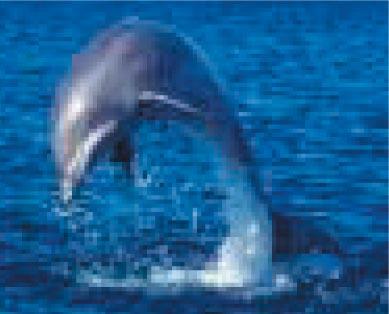The research was carried out by Prof. Daniel Weihs of the Faculty of Aerospace Engineering at the Technion and Professors Frank Fish and Anthony Nicastro from the West Chester University in PA.
The new research refutes the traditional theory that the dolphin pirouette is made possible thanks to the rapid movement of the dolphin's tail in the air. "Dolphins are not very flexible and it is not likely that the movement of the tail in the air would enable them to perform the pirouette," says Prof. Fish.
Based on biomechanical and hydrodynamic principles collected from studies on dolphins and fish, the three researchers formulated a mathematical model that integrates the physical principles that enable the dolphin pirouette. According to this model, the dolphin begins to spin while still underwater. All the time that the dolphin is underwater, the spinning is slow due to water resistance. When the dolphin leaps out of the water, resistance decreases suddenly and thus - with the final movement of the tail in the water - the spinning intensifies, enabling the pirouette. The model explains how the speed of the dolphin's spinning when emerging from the water - six meters per second - enables it to perform seven spins before falling back into the water.
"The dolphin pirouette," the researchers explain, "is not a form of playing or done for fun." It has a purpose. The force of the dolphin hitting the water is so great that it removes parasites such as remora, which feed by attaching themselves to sharks and dolphins. The researchers succeeded in calculating the force of hitting the water by breaking it down into its various components.
"The rapid spinning movement causes the remora to be torn away from the dolphins, and if this is not enough to disconnect it, then the blow that the parasite receives when it hits the water will cause it to be removed," explains Prof. Weihs.
"This article presents the only basic research on the dolphin pirouette from the biomechanical and hydrodynamic point of view," states Prof. Malcolm Gordon, a marine biologist from the University of California - Los Angeles. "The article completely refutes the traditional theory on this subject."
Last year, Prof. Weihs succeeded in explaining an amazing natural phenomenon - how the mother dolphin keeps her offspring swimming in tandem with her for the first full three full years of its life.
 A Technion Institute of Technology researcher, in cooperation with American researchers, has solved the mystery of the technique used by dolphins in their "aerial dance". The journal "Science" reports that this research, which was recently published in the "Journal of Experimental Biology", sheds light on the "dolphin pirouette" - the rapid spinning in the air that dolphins leaping out of the water perform.
A Technion Institute of Technology researcher, in cooperation with American researchers, has solved the mystery of the technique used by dolphins in their "aerial dance". The journal "Science" reports that this research, which was recently published in the "Journal of Experimental Biology", sheds light on the "dolphin pirouette" - the rapid spinning in the air that dolphins leaping out of the water perform.